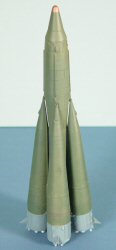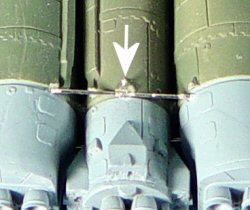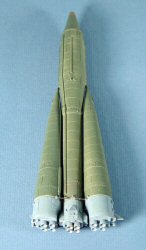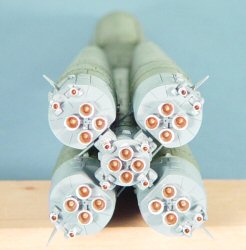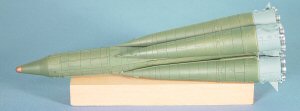
Cutting Edge's Lift Off Series 1/144 SS-6 Sapwood ICBM Build Review
By Michael Benolkin
| Date of Review | August 2003 | Manufacturer | Cutting Edge |
|---|---|---|---|
| Subject | SS-6 Sapwood | Scale | 1/144 |
| Kit Number | CELO44007 | Primary Media | Resin |
| Pros | Nice casting | Cons | |
| Skill Level | Intermediate | MSRP (USD) | Out of Production |
Background
The SS-6 'Sapwood' Intercontinental Ballistic Missile was the Soviet Union's first operational ICBM. With a range of 6,500 nautical miles, the SS-6 could carry a warhead of over 9,000 pounds with an accuracy (CEP) of 2 nm. Since the early Soviet warheads were heavier per yield than their US equivalents, the Soviets developed an array of heavy-lift vehicles that could carry these payloads with the same range and accuracy as their US counterparts.
In addition, the R-7 series of launch vehicles, which the SS-6 is based upon, were far more capable and reliable, giving the Soviet Union the springboard upon which to launch the first satellite into orbit, and later, the first man (Yuri Gagarin) into space. Both of these achievements were accomplished on the R-7 series, and though the SS-6 was decommissioned in 1968, the R-7 series continued to push payloads into space well into the 1990s.
The Kit
The Cutting Edge 1/144 SS-6 kit, like the other two R-7 kits reviewed elsewhere in this issue, is based upon a liquid fuel four-engine main stage with four four-engined strap-on boosters. That translates into five solid pieces of nicely cast resin, with additional parts for rocket nozzle bottom plates for all five pieces, and an additional 12 vernier engine nozzles for vehicle steering.The upper portion of each booster attaches to the side of the main stage. The lower portion of the strap-on is held within one portion of a tic-tac-toe-like frame where the main stage runs through the center square and each strap-on mounts onto one of the middle edges. I had build the Apex release of this kit and attachment of the five main pieces was straightforward given the lack of mass of each piece and the durability of liquid cement. Given that these five pieces are solid resin, a bit of engineering was required to provide a solid and durable installation.
I decided to drill holes into the side of the main stage, one just above the tic-tac-toe collar at each of the four points where each of the four strap-on boosters would come the closest to the bottom of the main stage. I drilled a corresponding hole in each of the four strap-on boosters. Much to my surprise, I found that I did not have any brass rod handy, but the solution came in the form of standard steel straight pins. I used my handy metal cutter (this is a must-have tool that radio control modelers use to cut various diameters of brass rod for control linkages etc) and cut the straight pins to the appropriate lengths.
After dry-fitting the pinned stages, I used gap-filling cyano to assemble the model. The model went together with absolutely no problems. Given the mass of the five stages, do give the cyano a good period of time to cure. I also used lengths of straight pin to replicate the tic-tac-toe frame in order to provide additional strength to the assembly.
Painting
I happened to be watching the Discovery channel and there were some great shots of the R-7 vehicle. While the space launchers appeared to be white or light grey, I projected that the SS-6 was classic Soviet Green with details brought out here and there. It just so-happened that the best acrylic green I had handy was Tamiya XF-65 Field Grey (go figure). A quick shot with the airbrush, adding some grey and copper highlights finished the job. I happened to notice that the R-7s appeared to have silver engine bells, though the inside of those bells was an interesting reddish-copper. I chose to replicate that look as it adds some additional interest and contrast to the finished project.
This kit is one of three in the R-7 series released by Cutting Edge (Meteor Productions) and goes together nicely. I did apply those engineering changes to the assembly only because I don't trust cyano and heavy resin to be as resilient on the shelf as styrene and cement. Any modeler comfortable and equipped to work with resin can build this kit with no problems.
Conclusions
My sincere thanks to Meteor Productions for this review sample!








